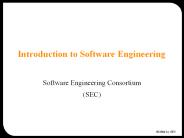2.2 Software Myths - PowerPoint PPT Presentation
Title:
2.2 Software Myths
Description:
Hardware is cheap compared to other electromechanical devices ... 8 errors remained in code used in flights, though not encountered. Myth 3/ Cont. ... – PowerPoint PPT presentation
Number of Views:2818
Avg rating:3.0/5.0
Title: 2.2 Software Myths
1
2.2 Software Myths
- Myth 1. The cost of computers is lower than that
of analog or electromechanical devices. - Hardware is cheap compared to other
electromechanical devices - However cost of software, with reliability and
maintenance, is enormous - e.g. Space-Shuttle software has 400,000 words
(relatively small) but costs NASA approximately
100,000,000 a year to maintain. - Software Costs can become exorbitant over time.
2
Myth 2. Software is easy to change.
- Yes changes are easy to make -- but hard to make
without introducing errors. - Every change must be verified and rectified
- Becomes more brittle with changes
- We become hesitant to change software over time
-- recognizing
3
Myth 3 Cont.
- Little available data on software reliability vs.
non-computer systems - British Royal Signals and Radar Establishment
analyzed software for highly safety critical
purposes. - 10 of modules or functions deviated from
original design. - Deviations found even in tested software.
- 1 in 200 new modules had errors with observable
effects on performance. - Integer overflow errors.
- Complete error elimination is a hard and lofty
goal to achieve.
4
Myth 3 Cont.
- These are not just teething problems but
chronic ones over tens or hundreds of hours of
use - e.g. (1) Therac-25 worked correctly thousands of
times before first know overdose occurred. - (2) Space Shuttle -- NASA invested
enormous effort and resources since 1980 - yet 16 severity-level 1 software errors have been
discovered (errors that would result in loss of
shuttle or crew - 8 errors remained in code used in flights, though
not encountered
5
Myth 3/ Cont.
- 12 errors with lower severity triggered during
flight 3 threatened mission, 9 had to be worked
around - ALL DESPITE THE SOPHISTICATION OF NASAs software
development and verification program.
6
Myth 3/ Cont.
- Redundancy is not a solution as in the case of
hardware wearout. - Zero-Defect software is false claim.
- Usually not enough time to perfect software
costs also severe. - Computers may be more reliable but not
necessarily safer.
7
Myth 4 Increasing software
reliability will increase safety
- Software errors may not be related to safety at
all - Compliance with requirements specification may
not remove errors - Safety-critical software errors can often be
traced to Requirements - That is, software is doing exactly what it is
supposed to do. - Software may be correct and 100 reliable -- yet
responsible for serious accidents. - RELIABILITY DOES NOT EQUAL SAFETY
8
Myth 5 Testing software or proving (using
formal verification techniques) software correct
can remove all the errors.
- Software limitations well known
- Exhaustive testing is impossible
- Only a relatively small part of the state space
can be covered - Despite improved testing techniques, no
breakthroughs - Mathematical proofs advanced -- but even
arguments for impossibility of complete proof of
correctness - Mathematical verification of software may be
possible in the future.
9
Myth 5 /cont.
- Correct behavior of software must be specified in
a formal mathematical language. - May be as difficult and error-prone as the code.
- Software errors often involve overload -- outside
the realm of specification - Intricate software interactions complicate the
issue. - In summary, most safety-related software errors
can be traced to the requirements
10
Myth 6 Reusing Software increases safety
- Reuse of proven software may increase
reliability, but has little or no effect on
safety - May even decrease safety because of the
complacency it engenders - Specific hazards of new implementation may not
have been considered - Examples include
11
Therac-20 parts reused for Therac-25 with same
error, but causing two deaths
- Error did not have serious consequences in
Therac-20. - Resulted in occasional blown fuse -- not massive
overdose - Never detected or fixed in Therac-20
12
Air Traffic Control Software
- Successful in US for many years but not in Great
Britain - Was not developed for zero degrees longitude
along the Greenwich Meridian - Manchester plopped on top of Warwick
13
Aviation Software written for Northern Hemisphere
has problems in Southern Hemisphere
- Software written for US F-16s caused problems
when reused in aircraft flown over the Dead Sea
where altitude is below sea level. - Safety is not a property of software alone, but
of the software design, and environment where
software is used. - Application, environment, and system-specific.
14
Myth 7 Computers reduce risk over mechanical
systems
- Argument 1-- can check parameters through finer
control more often - Counter -- Finer control allows operation under
smaller safety margins - No way to test adequately
15
Myth 7 /cont.
Argument 2-- automated system allow operators to
work farther away from hazardous areas. More
accidents due to operators entry into 7 - 7
environment. Humans enter unsafe hazardous
environments Became unsafe to enforce robot
shutdown protocols
16
Myth 7/cont.
- Argument 3 -- eliminating operators eliminates
human errors - Argument 4 -- Computers have the potential to
provide better information to operators and
thus improve decision making - Argument 5 -- Software does not fail.






























